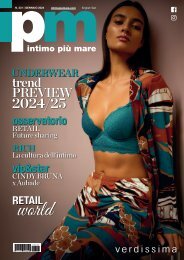Intimo più mare n° 199 - Marzo 2015
Create successful ePaper yourself
Turn your PDF publications into a flip-book with our unique Google optimized e-Paper software.
ENGLISH TRANSLATION<br />
believes that men’s fashions are evolving today based on movements<br />
in the society and the image that men want to project in<br />
these contexts. For men fashion represents a way of affirming their<br />
social status and creating their own style. “Men buy less items but<br />
of higher quality” explained Virginie Kollmann-Caillet in a study she<br />
conducted for the Salon de la Lingerie in Paris which set up a special<br />
customized devoted to the men entitled, Super Heroes. "When<br />
it comes to underwear they are primarily interested in the functional<br />
aspect and long wear. They tend to rely primarily on large,<br />
well-known brands, which on the one hand are the expression of<br />
a certain purchase power, but also the guarantee of sure value.<br />
The increase in the number of collections has brought with it a desire<br />
for a more authentic approach. Rather than slavishly following<br />
every trend that comes down the pike, men try to create a style that<br />
represents them. The new generations, the younger men, are the<br />
ones responsible for the current evolution on the fashion landscape<br />
which thanks to them combines seduction, comfort, innovation<br />
and confirmation of a style. And the boon in the new technologies,<br />
in intelligent fabrics and the change in mentality are opening new<br />
opportunities for the men’s intimate apparel market”.<br />
The men of theY generation<br />
In the wake of the X generation, the 2.0 generation, and as we wait<br />
for the Z generation, the men responsible for the current change<br />
belong to the Y Generation. A conference presented by Benoît Wojtenka,<br />
co-founder of BonneGueule.fr with the participation of Eric<br />
Briones (Darkplanneur), the head of strategic planning for Publicis<br />
EtNous and the co-author of Génération Y et le luxe, Régis Pennel,<br />
the founder of L’exception.com, Nicolas Gabard, founder of Husbands,<br />
illustrated the various different types of Y consumer.<br />
Just who are these Y men?<br />
They are aged between 14 and 34, which is to say that they were<br />
born between 1980 and 2000. Involved (in social causes, in some<br />
sort of ecological or political battle), multi-connected, free of complexes,<br />
forming activist groups, but individualists at heart: these are<br />
the distinguishing characteristics of this generation. They are fond<br />
of selecting their own clothing, but are more concerned with developing<br />
a style than following trends, making an effort to actually<br />
understand fashion. They have no faith in politics as a means of improving<br />
the world. They are open to luxury but inclined to criticize.<br />
The shopping behavior of Y men<br />
Y Generation men want to know what they are purchasing; the<br />
product has to have the right price, especially in relation to the<br />
quality it offers: a good product with a good price. He is sensitive<br />
to quality, but also aware of trends and the issue of design.<br />
He doesn’t want to spend his money on marketing fluff; the price<br />
consideration is of enormous importance. He is not inclined to<br />
pay unless he feels he is getting his money’s worth. He is eager<br />
to have as much information as possible about what he is buying.<br />
The product should provide education, not just information.<br />
Everything has to be connected, from the manufacturing to the<br />
actual purchase. It should tell a story. Give rise to thought. Y men<br />
display a high level of curiosity and the brands want to provide answers.<br />
Up until now the advertising campaigns conducted by the<br />
brands have provided little substantial communication regarding<br />
the actual product. Y man does not systematically renew his wardrobe.<br />
Another new development is the proximity, the confidence<br />
that must be established between the consumer and the brand.<br />
The luxury brands should not be inaccessible, but provide access<br />
and customization, passion, honesty, quality and fun. The Y man<br />
is the one who currently boasts the greatest purchase power and<br />
he will continue to be the primary target of the luxury brands from<br />
now until 2020. By focusing on targeting the Y man, it is possible<br />
to appeal to all the other generations. He has no moral compunctions<br />
when it comes to luxury, as opposed to the X Generation man.<br />
For the Y Generation man luxury is synonymous with perfect shopping,<br />
perfect buying, free of guilt, based on intelligent utilization.<br />
The majority of young men are not ashamed to purchase a luxury<br />
product, although they express doubts about the term and are nevertheless<br />
still interested in low-cost products. The age of accessible<br />
luxury is over because these products lack the allure of genuine<br />
luxury. The Y man, however, insists on testing and checking the<br />
value of the product, knowing how he spends his money and luxury<br />
must operate in terms of micro-actions of generosity associated<br />
with the purchase. Although he clearly loathes marketing it is in<br />
his DNA. The realm of luxury must therefore reinvent itself. For the<br />
Y man everything is concrete and associated with the product. In<br />
this context fast fashion represents a return to the great classics.<br />
How is one to communicate effectively with the Y man? And how<br />
is it possible to enable the brick-and-mortar stores to coexist with<br />
the Internet, the channel where this generation currently does most<br />
of its purchasing? Burberry, for example, in its flagship store has<br />
already integrated it. The opportunity is provided by the synergy<br />
between advertising and brand content for explaining the value of<br />
the product, coupled by the retail outlet where the shopper happens<br />
to be the best ally of this synergy. Men are no longer purchasing<br />
in order to demonstrate their status, but rather in order to<br />
affirm their personality. Frequently men will walk into a store to find<br />
something they already have in mind. The price has to be part of<br />
the information and the most crucial key is customer service. The<br />
Internet comes before a purchase made in a store and men are becoming<br />
increasingly inclined to make their actual purchases in the<br />
physical space of a store. In 2001 on purchase out of every 2 men’s<br />
clothing purchases were made by women. Now the proportion has<br />
skyrocketed to 8 purchases made by men out of 10. “Y men want<br />
to know where a product comes from”, explained Régis Pennel, at<br />
the conference. “This is the most significant factor in the evolution<br />
of the product. Today’s consumers need to understand what they<br />
are buying better and consequently even stores have to redefine<br />
them and reinvent themselves, as they make as effort to include<br />
less well-known brands that offer good value in terms of the pricequality<br />
ratio. This is the only way the brick-and-mortar stores will be<br />
able to stay in existence. They have to ignite the shoppers’ imagination<br />
and kindle dreams with a carefully selected array of products<br />
in an effort to generate a story. They have to rekindle the shoppers’<br />
desire to purchase. The young designers like the Y man because<br />
they can identify with their vision of style. Y men find that it makes<br />
more sense to buy these collections by relative newcomers rather<br />
than those of established luxury brands because they don’t feel like<br />
the price goes to financing costly advertising campaigns. When it<br />
comes to shopping behavior women are famous for their tendency<br />
to make impulse purchases; men, on the other hand think things<br />
over and evaluate such rational factors as how low an item is likely<br />
to last. Men purchase some 60-70% of their wardrobes during<br />
end-of-season sales. Women shop and make purchases throughout<br />
the course of the year. Men must bee assisted when they are<br />
shopping and this service must be personalized”.<br />
The Manufacturers’ Point of View<br />
Moving right out into the field, we asked a number of especially<br />
representative manufacturers who their ideal shoppers would be<br />
and whether the type of people they are targeting purchase exclusively<br />
their underwear, hosiery and pajamas and what they prefer.<br />
Matteo Restelli (Manifattura di Valduggia/Ragno)<br />
For us pining down in a precise manner what an average consumer<br />
of our products would be is very difficult as we have a farranging<br />
array of products suitable for a highly mixed target. More<br />
specifically, we are able to satisfy the needs of young consumers,<br />
concerned with fashion trends, with the Forniture Militari by Ragno<br />
line while, at the same time, we are equally capable of appealing to<br />
those in quest of high-end products with our Julipet and Trussardi<br />
lines, exclusive products that combine top quality primary materials,<br />
scrupulous study of the garment in order to offer maximum<br />
comfort to the wearer. And, last but not least, there’s the high-end<br />
Ragno line with its high-performance products: Kontakt extra skin,<br />
SilKotton mercerized cotton and WSK.


















